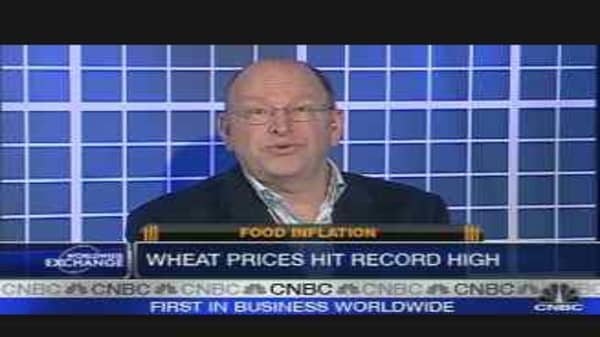"I would expect wild swings in the market until things become clear about plantings," said Mark Samson, vice president for South Asia of U.S. Wheat Associates, a body representing U.S. wheat farmers and exporters.
The bellwether Chicago Board of Trade March wheat (WH8) contract rose by the 30-cent-per-bushel daily trading limit to $10.09 per bushel, before falling back to $10.01.
However, deferred contracts representing new-crop wheat fell on an improved outlook for the 2008 crop, especially in the southern U.S. Plains.
"People just want to keep buying wheat after they checked last week that concerns over credit market and global economy did not hit demand for grains," said a trader at an international grain house.
With world wheat stocks seen dwindling to 30-year lows by the end of the 2007/08 marketing year, and India and Pakistan scouting the market for large volumes of wheat, traders said
there was very little chance for a big correction in prices.
In addition, Australian wheat exports are likely to be nearly halved as stocks run out after two successive years of drought.
"It's a scramble everywhere and there will be a lot of rationing in the market," said one Singapore-based trader.
David Johnson, the general manager of the national wheat pool for Australian export group AWB, said overseas buyers were reluctant to commit to large tonnages given rising prices as their flour milling margins were negligible.
"While we have locked in significant sales sales over the past few months, many buyers are shying away from the current high prices," Johnson said.
The U.S. Agriculture Department reported on Thursday weekly export sales of U.S. wheat at 516,800 tonnes, above trade estimates for 300,000 to 400,000 tonnes.
n the supply side, Argentina's Agriculture Secretariat halted wheat exports early December for several days to assess cold-weather damage.
Rising prices of wheat have forced millers in Asia to pass on the additional cost to consumers, leading to protests and governments making efforts to control rising good costs.
Consumers in Pakistan are voicing their dissent against President Pervez Musharraf for failing to control prices.
Consumers are blaming hoarders and smugglers for depleting what they say has been a bumper crop to cash in on prices that are higher abroad than in the domestic market.
China, which has frequently sold wheat from reserves this year, boosted domestic sales this month in a bid to cool prices and on Monday said it would scrap tax rebates on exports of
grains to discourage sales abroad.
AWB's Johnson said world supplies of wheat were likely to remain tight through the first half of 2008 until the northern hemisphere wheat arrives.
Soybeans Surge
Soybeans received a boost after a big number for soy in the U.S. Agriculture Department's weekly export sales report.
USDA said last week that 972,400 tonnes of soy were sold for export, above estimates for 600,000 to 700,000 tonnes.
The U.S. Senate's passage late on Thursday of an energy bill to boost biofuel production five-fold to 36 billion gallons by 2022 was another harbinger of the demand for agricultural products.
January soybeans (SF8) rose 15 cents to $11.72 per bushel, after hitting $11.73-3/4, while January soyoil (BOF8) was up 0.38 cents at 46.60 cents a lb.
Traders said agriculture would likely be the most recession-proof of all asset classes.
"Ongoing weather-related supply disruptions in wheat and robust demand growth for soybeans from both the biofuel and feed end-use sectors have pushed nominal prices of both of these crops to record-high levels," Goldman Sachs said last week.



